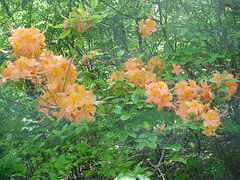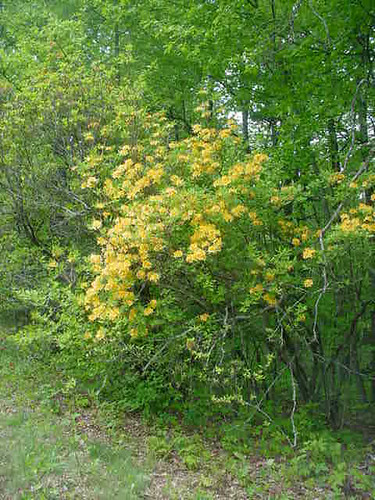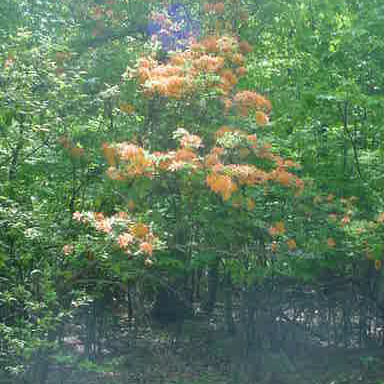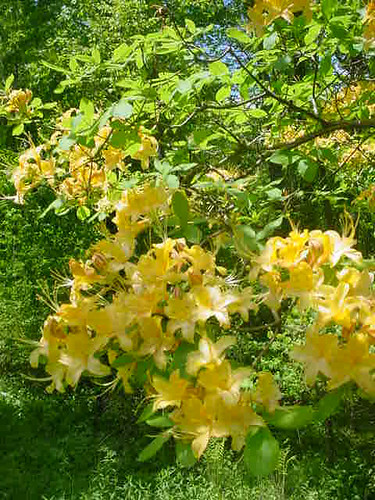Blue Ridge Glory: Deciduous Azalea

Deep orange tones and large flowers characteristic of deciduous azalea
In the fall people flock to the Blue Ridge Mountains to admire the beauty of the changing autumn leaves. The fall foliage is lovely, and well worth the trip, but don't ignore the beauties of an early spring in the mountains. Depending on conditions, the bloom of spring flowers, shrubs and trees along the Blue Ridge Parkway and across the mountains is well worth a trip in late April, through May and into June.

A lighter colored deciduous azalea
The changing shades of the mountains in early spring spread across the mountain, as trees bud out in cool mountain breezes and cast a green, gold, red and blue haze across the mountains. Intermingled with the new leaves blooming trees stand out. Sarvis or serviceberry (Amelanchier arborea) and flowering dogwood (Cornus florida) shimmer white in the spring sunshine, followed by Tulip Poplar (Liriodendron tulipifera), mountain magnolia (Magnolia fraseri) and Princess Tree (Paulownia tomentosa). Dozens of wildflowers bloom in the spring, painting the fields and forests with a special beauty only seen at this time of the year.

Dark orange flame azalea at the edge of a woods
For me the most stunning native wildflower of the Blue Ridge Mountains is a small shrub that spends a few spring weeks covered with a brilliant orange, yellow or even pink bloom. Deciduous azalea, sometimes called flame azalea, is a member of the rhododendron family (Rhododendron calendulaceum) and, unlike some other rhododendrons, loses its leaves for the winter. The shrub can grow 4 to 8 feet in height, and grows at the shady edge of a woods, in acid soil. They are well adapted to the harsh weather of a mountain winter and often seem to bloom better after a cold winter.

Flame azalea
When I was a child the local people called flame azalea "honeysuckle", probably because of the shape and color of the flowers. There are many variations of this native species, with different colors and patterns of the flowers according to variety and perhaps location. This article at the Potomac Valley Chapter of the American Rhododendron Society web site explains many of the varieties of native flame azalea that have been found in the Blue Ridge Mountains and offers some reasons for the variation in color. Although native flame azalea is sensitive and grows best in conditions present in the mountains, there are many hybrid varieties that are adaptable to more varied environments.
Unlike the larger rhododendron that grows abundantly along the Blue Ridge Parkway and other mountain roads, flame azalea is a little less common, sheltering in the under story of a mostly hardwood forest in our region. The sight of this glorious yellow or orange blooming shrub, standing eight feet tall against the soft greens of a spring forest, is a special treasure to enjoy along with the other wonders of the Blue Ridge Mountains.
Technorati Tags: [Blue Ridge][Native Wildflowers][Flame Azalea][Rhododendron][Spring][Flowering Shrubs][Flowering Trees]












3 Comments:
At Saturday, 20 May, 2006, D L Ennis said…
D L Ennis said…
These azaleas are so beautiful, great post and images!
At Saturday, 20 May, 2006, John Roberts said…
John Roberts said…
Flame azaleas are among my favorites. Very informative article!
At Sunday, 21 May, 2006, The MacBean Gene said…
The MacBean Gene said…
Fall gets all the attention but this spring the variety of blooms along the Parkway are just as wonderful.
Post a Comment
<< Home